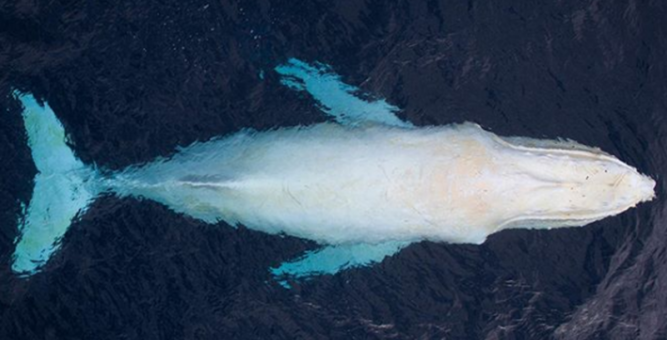
This summer, the most famous humpback whale in the world was spotted off the Australian coast. The whale, who was swimming alongside another whale in the waters of New South Wales, is believed to be the only albino humpback whale in the world. Named “Migaloo,” the 40-foot-long giant of the sea was photographed by Craig Parry, who happened to be four miles off Cape Byron when he saw Migaloo. Parry noted that there have been numerous sightings of Migaloo heading north between south coast New South Wales and Byron Bay, adding “Let’s hope we get catch [sic] up with our old friend at some stage!”
The 41-year-old photographer added, “Honestly there aren’t many milestones as an artist, but I would have to say I count this moment with Migaloo as a significant time in my life, not just as a photographer but human.” He shared that this year, he has been deeply inspired as he hits the Great Barrier Reef, Tonga, Africa, and Europe, and says he’s enjoying his role in helping to connect humanity back to nature. The Pacific Whale Foundation website states that Migaloo may be the only pure white adult humpback whale alive in the world today. Migaloo was first spotted by volunteers who were conducting a whale count in 1991 off Byron Bay, Queensland.
The very first photograph of Migaloo was actually taken via a telescope from more than five kilometers away. The photo was blurry and unclear, and researchers weren’t certain that he was all white. However, in 1993, researchers with the Pacific Whale Foundation encountered Migaloo in Hervey Bay, Queensland and they were able to confirm that he was indeed all white. Then, in 1998, the researchers were able to record Migaloo singing, and that confirmed that he was a male. Only male humpbacks sing. In 2004, genetic testing conducted by scientists at Southern Cross University further confirmed that the beautiful beast is male.
When the organizations confirmed his existence with the public, the public begged them to name the. The name “Migaloo” was chosen by the elders of Hervey Bay’s local aboriginal collective. It means “White Fella.” The elders of the tribe further explained that all-white or albino animals are to be respected and even revered. Migaloo can live to be up to 100 years old.
Migaloo is strictly protected by the Australian government, which is a good thing because humans tend to screw things up when they can. Migaloo was nearly hit by a boat in 2003 because some people were over-excited to get a look at him. All humpback whales are protected under federal law, but whales that are more than 90% white have “special management marine mammal” status and boats and vessels can’t approach Migaloo within 500 meters, and aircraft can’t approach him within 610 meters.
